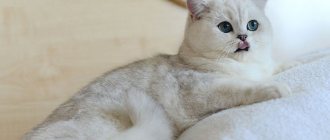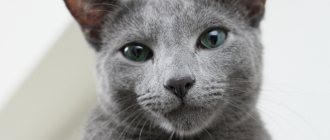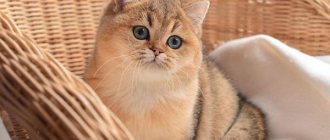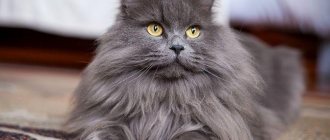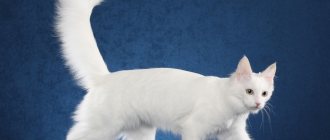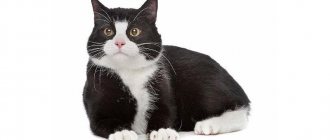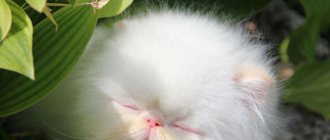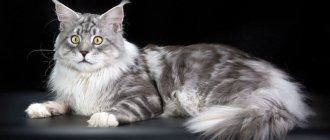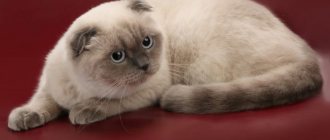Description of British Shorthair cats and photos
They come in medium to large sizes. According to legend, they are descendants of the Cheshire cat.
The British cat began to be in demand back in the 19th century. The breed was developed in England by crossing an English domestic cat with a Persian cat.
The British began to be exhibited at exhibitions as the first purebred cats, where they were recognized as the best. Then these animals were popular among aristocrats. Later they began to be in demand not only in England, but throughout the world.
Today, these cats have become so common that they are found in almost every home, regardless of the status of the owner; their great demand is explained by their cute appearance, similar to a plush toy, and their good adaptation to any conditions.
British Shorthair cat photo
British kitten price in Russia and Ukraine
- The price in Russia is from 2,500 to 30,000 rubles.
- Price in Ukraine – from 1500 to 10000 hryvnia.
In order to buy a healthy and purebred animal, it is recommended to choose it in nurseries, of which there are a lot in Russia and Ukraine. Here are some of them:
In Russia:
- "Silver Shine" Ekaterinburg;
- "SunRay" Moscow;
- "Wonder Plush" Moscow.
In Ukraine:
- "Fantasy Fiesta" Odessa;
- “Bastet Mystery” Zaporozhye;
- "Imperial Brilliant" Poltava.
External description of British shorthairs
- the head is large, round in shape, flat skull, wide cheekbones and large, full, slightly sagging cheeks;
- the neck is short and strong, with a pronounced skin fold around it;
- the nose is of medium length, wide, forming a depression at the transition to the forehead;
- the chin is well developed and strong, located in line with the upper lip and nose;
- medium-sized ears, rounded at the tips, set low;
- the eyes are huge and round, widely spaced from each other, have a pure, rich color, the most common is bright orange, blue and green are also found;
- the body is medium-sized, closer to large, squat and massive, has a flat back and a wide chest, weight from 4 to 6 kg;
- the legs are muscular, short in length, the paws are round and dense;
- the tail is short, fleshy, thickened at the base and gradually tapers at the tip;
- the coat is short, dense, thick and resembles plush, it is of the same length, developed undercoat, has an average degree of hardness, there is no tight fit to the body, therefore a weakly defined hedgehog is formed on the body, the colors can be varied.
There is a variety of this breed - the British Longhair cat. She appeared from crossing British and Persian cats. As a result of such experiments, short-haired representatives acquired a gene that is responsible for the development of long hair, but a weak and long-haired kitten can only appear if both parents are carriers of this gene. The fur of long-haired cats does not require special care and does not mat.
Some people mistakenly believe that there are British Fold cats. In fact, there are no such cats in nature. There is a breed of Scottish Fold, which is significantly different from the British one.
British cat character
The British Shorthair cat has a complex character. She is reserved, balanced and calm, not very active, prefers the slow and calm course of her usual life. With age, these cats begin to show qualities such as sedateness and importance. They do not become very attached to their owners and avoid strangers. Personal space is important to them; sometimes these animals can hide in a secluded corner, wanting to be alone with themselves.
These cats do not accept abundant displays of love, excessive attention from humans, they do not tolerate being carried and constant squeezing. The character of such pets is distinguished by leadership qualities. They do not like closed doors, perceiving them as an obstacle in their path, and begin to meow indignantly
These animals are good family men and homebodies. They get used to all family members, and not just one, perceiving their household members as a flock of which they themselves are a part. They also get along well with other pets, including dogs, and are not jealous of their owners. Their character largely depends on the atmosphere in the house: if it is calm, then the cat will be friendly, and if the atmosphere is nervous, then the cat can become aggressive. In character, these pets often resemble their owner.
The British are distinguished by aristocratic manners, which are passed on to them by inheritance; they will never misbehave or spoil anything. They are clean and well-mannered, so there are no problems with the tray and scratching post. These animals will always find something to do with themselves, but despite their independence, they miss them in the absence of their owners, and upon their return they greet them with affection and purring.
How to choose?
When choosing a golden kitten, you need to decide on the following points:
- the character traits of which breed appeal more;
- a kitten is purchased only for an adult or for a family with a child;
- readiness for everyday care;
- Is the chinchilla expected to live in the house with other representatives of the fauna?
For adults who have no other pets in their home, of course, you can choose any kitten you like based on suitable characteristics and preferred color. Families with small children or other animals are better off choosing the Scottish breed.
It is better to get a Persian chinchilla for those families where children have already reached the age of 10, as it behaves warily towards small children
If suddenly the baby persistently shows attention to the cat at a moment when it is not in the mood, then it may show aggression: hiss intimidatingly, scratch or bite
When purchasing, it is important to find out the availability of vaccinations, and, if possible, study documents related to the pedigree
In addition, you should take into account the fact that babies up to 3 months can be tabby in color, but as the cat gets older, it will become more uniform. Therefore, many responsible breeders do not sell kittens under three months of age, but give them the opportunity to spend longer with their mother so that their color, healthy psyche and immunity are finally formed.
Breeding and caring for the British
The British Shorthair cat is unpretentious in care, which is limited to a few standard procedures. Once a week, the fur requires combing using rubber brushes; if this is not done, the thick coat may fall off, forming tangles. During the period of active molting, this procedure must be done once every two days. It is recommended to bathe these animals no more than twice a year; they do not like water. When dirty, clean your ears and eyes using a damp cotton pad. Also, to avoid the formation of tartar, your pet should have regular teeth cleaning or be given special food that removes plaque. Equally important is timely vaccination and deworming.
What to feed the British
These cats are prone to obesity, which can subsequently cause various diseases. Therefore, the owner must monitor the pet’s diet and the amount of food consumed. It is better not to give food from the table, especially sweet, fatty and starchy foods.
A good option is dry and soft food of at least premium class. The consumption rate is usually written on the packaging. A kitten up to 6 months of age is fed 3 times a day, an adult cat - 2.
When compiling a diet from natural products, you can focus on low-fat beef, vegetables, fermented milk products, cereals and vegetables. It is better to cut the meat into pieces so that the animal, while chewing them, develops its jaws and cheeks. It is advisable to add vitamin complexes.
Reproduction of pets of the British cat breed
Mating of British cats and female cats is allowed upon reaching the age of one year. This breed takes a long time to develop its body, which ends only by the age of three. The formation of cats is completed after the second birth. Mating, pregnancy and childbirth proceed as standard; no difficulties should arise. These cats are caring mothers who look after their kittens with special care, raise them and protect them.
Possible diseases
The health of cats directly depends on heredity; immunity is passed on from the parents. In general, chinchillas are in good health, but may be prone to certain diseases.
Retinal atrophy is damage to light-sensitive receptors in the retina of the eye. Symptoms include dilated pupils, shiny eyes, and sudden onset night blindness. The animal stops seeing in the dark, and in advanced cases can completely lose vision. Unfortunately, there is no effective treatment for atrophy
It is important to maintain eye hygiene to prevent dirt from accumulating on them.
Caries. For prevention, it is important to brush your teeth, and if caries is detected, contact your veterinarian immediately.
Hypertrophied cardiopathy is a heart disease in which the wall of the ventricle thickens
May cause the cat to develop heart failure or thromboembolism. It can only be detected using ultrasound. At the beginning of the disease, the animal may notice shortness of breath and fatigue. Timely diagnosis and timely treatment begin guarantee a favorable outcome.
Polycystic kidney disease is a disease of the genitourinary system in which cysts appear in the kidneys. It is very difficult to recognize the manifestations of the disease at the initial stage, but still, if it is possible, then surgical removal of the cyst is performed. But most often, symptoms become noticeable only when the formations greatly increase in size and the cat experiences pain. If cysts are detected by simple palpation of the abdominal cavity, then the operation is pointless. It is no longer possible to save the animal, since the kidneys cannot function normally. Only a special diet and drug therapy prescribed by a veterinarian can alleviate suffering. They will be able to extend the life of the pet.
British cat color
There are about two hundred recognized colors of British cats. The most popular of them is blue. But other colors are also in demand.
Colors of British cats (photos of British kittens)
The most common colors of the British are:
- solid or plain - an important criterion for this color is the uniform coloring of each hair from root to tip in one color; there are colors of lilac, blue, black, chocolate and red;
- tortoiseshell - a combination of several shades;
- colorpoint – Siamese color;
- smoky - up to half of the hairs are colored white, and the upper part is the main color;
- chinchilla - only the tips of the hairs are colored, while the undercoat is white;
- bicolor – white color is combined with the main color;
- tabby – silver or gold shade with various patterns (marbled, ticked, striped)
British cat photo
Colors
The main types of color are considered to be golden British and silver variants. But other shades are known, more than 30 in total. The black version of the shade is considered rare: with age, the rich color turns into dark brown or chocolate.
https://youtube.com/watch?v=W32PwxAlPl8%3F
Golden
The British Golden Chinchilla's coat resembles that of an Arctic fox. Fur color is soft peach or cream, reddish. At the end of the hair the shade becomes darker or turns into a bright smoky color. Options for alternating colors:
- Brown.
- Dark grey.
- Ginger.
The tail, ears and sides of the body usually have a richer color. The color should be even, without spots.
Silver
The dominant color of the British Silver Chinchilla is white. The tips of the fur are 80% black. It gives the impression of shimmering silver and shine on the back and tail. A distinctive feature is the pure white undercoat. The British point chinchilla has a very light shade of fur, almost snow-white.
https://youtube.com/watch?v=gCXlPqi7Uww%3F
Ticked
The ticked representative of the breed is evenly covered with alternating stripes: smooth transitions of dark and light shades. On the back the ticking is usually more noticeable.
Shaded
The coat of a shaded chinchilla is 1/3 darker than the main shade. The undercoat, like that of a silver chinchilla cat, is pure white. A rich shaded transition to the chest and tummy is possible. The tail is black at the end.
White
There is an opinion that a variety of silver colors are mistaken for white chinchillas. The owner of an impeccably white coat has a uniform uniform color along the entire length of the coat. The white British chinchilla has a wide range of eye shades: from blue to soft gold.
